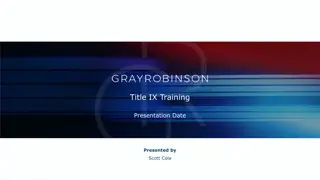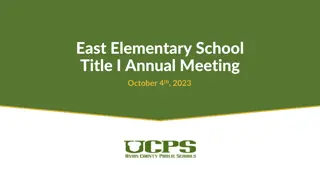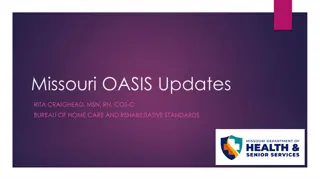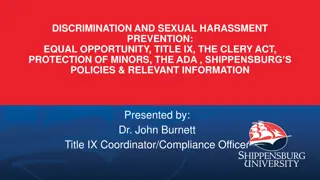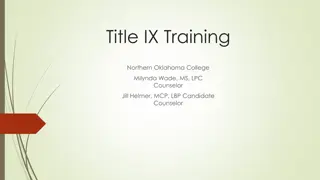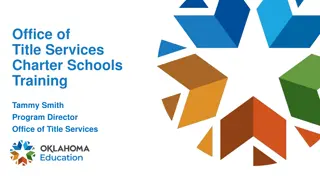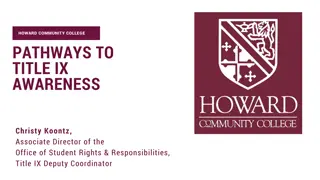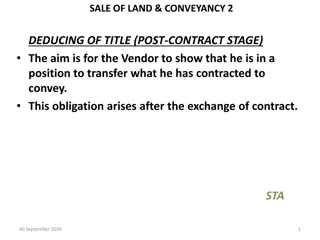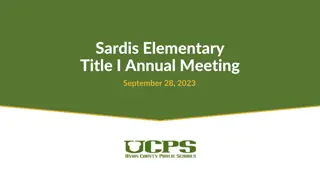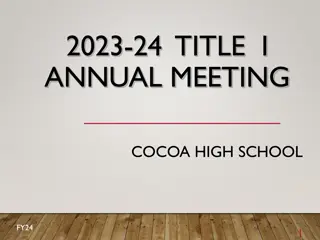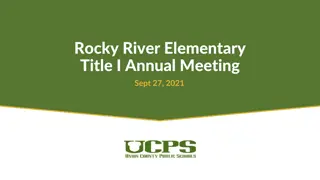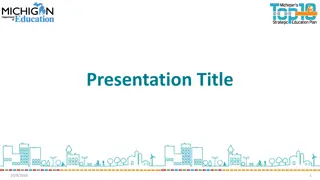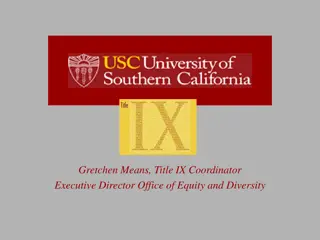
Understanding Title IX: Sexual Harassment, Equal Opportunity, and Grievance Process
Explore the significance of Title IX in addressing sexual harassment, promoting equal opportunity in education, and ensuring fair grievance procedures. Learn about the duties of a Title IX Coordinator, the definition of sexual harassment, and the importance of impartiality.
Uploaded on | 0 Views
Download Presentation

Please find below an Image/Link to download the presentation.
The content on the website is provided AS IS for your information and personal use only. It may not be sold, licensed, or shared on other websites without obtaining consent from the author. If you encounter any issues during the download, it is possible that the publisher has removed the file from their server.
You are allowed to download the files provided on this website for personal or commercial use, subject to the condition that they are used lawfully. All files are the property of their respective owners.
The content on the website is provided AS IS for your information and personal use only. It may not be sold, licensed, or shared on other websites without obtaining consent from the author.
E N D
Presentation Transcript
COURSE OBJECTIVES COURSE OBJECTIVES What is Title IX of the Educations Amendment Act Definition of Sexual Harassment/Sexual Violence Definition Equal Opportunity in Educational Programs & Pregnancy Rights under Title IX Why a Title IX Coordinator Duties and Responsibilities of the Title IX Coordinator Fairness and Impartiality The Importance of understanding Biases and Stereotypes Title IX Grievance Process Title IX Policy & Procedures
"No person in the United States "No person in the United States shall, on the basis of sex, be shall, on the basis of sex, be excluded from participation in, excluded from participation in, be denied the benefits of, or be denied the benefits of, or be subjected to discrimination be subjected to discrimination under any education program under any education program or activity receiving Federal or activity receiving Federal financial assistance." financial assistance."
TITLE IX OF THE EDUCATION AMENDMENTS ACT OF 1972 Title Title IX IX addresses addresses: : Sexual Sexual Harassment Harassment and Equal Equal opportunity opportunity in in educational Discrimination Discrimination based and Sexual Sexual Violence educational programs based on on pregnancy pregnancy Violence in in Education programs Education It It is is the address address any sexual sexual violence violence the college s college s responsibility any sexual sexual discrimination, responsibility to to take discrimination, sexual take immediate immediate steps sexual harassment, harassment, or or steps to to
WHAT IS THE DEFINITION OF SEXUAL HARASSMENT/SEXUAL WHAT IS THE DEFINITION OF SEXUAL HARASSMENT/SEXUAL VIOLENCE UNDER TITLE IX VIOLENCE UNDER TITLE IX Sexual Harassment is defined by utilizing a three Sexual Harassment is defined by utilizing a three- -prong approach on the bases of conduct of a sexual nature that satisfies one or the bases of conduct of a sexual nature that satisfies one or more of the following: more of the following: prong approach on (1) (1) An An employee employee of of the service service of of the conduct conduct; ; the recipient recipient conditioning the recipient recipient on on an conditioning the an individual s individual s participation the provision provision of of an participation in in unwelcome an aid, aid, benefit, unwelcome sexual benefit, or or sexual (2) (2) Unwelcome Unwelcome conduct and and objectively objectively offensive recipient s recipient s education conduct determined determined by offensive that education program program or or activity by a a reasonable reasonable person that it it effectively effectively denies activity; ; or or person to to be denies a a person be severe, severe, pervasive, person equal equal access pervasive, access to to the the (3) (3) Sexual Sexual Assault defined defined in in 34 12291 12291 (a)( Assault as 34 U U. .S S. .C C. . 12291 (a)(8 8), ), or or stalking stalking as as defined defined in in 20 12291 (a)( 20 U U. .S S. .C C. . 1092 (a)(10 10), ), domestic domestic violence as defined defined in in 34 34 U U. .S S. .C C. . 12291 1092 (f)( (f)(6 6)(A)(v), )(A)(v), dating violence as as defined 12291 (a)( (a)(30 dating violence violence as defined in in 34 30) ). . as 34 U U. .S S. .C C. .
PRONG 1 QUID QUO PRO Conditioning provision of an aid, benefit, or service based on Conditioning provision of an aid, benefit, or service based on participation in unwelcomed conduct of a sexual nature. participation in unwelcomed conduct of a sexual nature. Quid Quo Pro This for that Mainly conducted by those in a position of authority. One incident is sufficient to initiate a Title IX Grievance Process
PRONG 2 HOSTILE ENVIRONMENT Unwelcomed sexual conduct that is severe, pervasive, and Unwelcomed sexual conduct that is severe, pervasive, and objectively offensive. objectively offensive. Behavior includes the subtypes of sexual harassment (Third Party, Sexual Favoritism, Sex-Based) The conduct effectively denies equal access and must occur within The conduct effectively denies equal access and must occur within the context of an educational program or activity. the context of an educational program or activity. Determined by a reasonable person standard (standing in the shoes Determined by a reasonable person standard (standing in the shoes of the complainant) of the complainant) This Behavior is so frequent or serious that it effectively denies a This Behavior is so frequent or serious that it effectively denies a person equal access to the educational program or activity. person equal access to the educational program or activity.
PRONG 3. SEXUAL ASSAULT Sexual Assault Sexual Assault a forcible or non attempted rape, sodomy, fondling, statutory rape. attempted rape, sodomy, fondling, statutory rape. a forcible or non- -forcible sex offense including rape, forcible sex offense including rape, Dating Violence Dating Violence - - violence by a person who is or has been in a romantic or violence by a person who is or has been in a romantic or intimate relationship. intimate relationship. Domestic Violence Domestic Violence violence by a former or current spouse, intimate violence by a former or current spouse, intimate partner, co partner, co- -parent, live in partner, youth, or categories under other state parent, live in partner, youth, or categories under other state law. law. Stalking Stalking fear of own safety, or safety of another, or to suffer substantial fear of own safety, or safety of another, or to suffer substantial emotional stress. emotional stress. One incident is sufficient to initiate a Title IX Grievance Process One incident is sufficient to initiate a Title IX Grievance Process
SEXUAL HARASSMENT JURISDICTIONAL CRITERIA For sexual harassment to be considered within the authority of Title For sexual harassment to be considered within the authority of Title IX the alleged conduct must: IX the alleged conduct must: M Meet The act must occur in the Institution s educational programs or The act must occur in the Institution s educational programs or activities (on or off campus). activities (on or off campus). The act must have occurred against a person within the United The act must have occurred against a person within the United States. States. eet the Title IX definition of Sexual Harassment the Title IX definition of Sexual Harassment. .
MANDATORY REASONS FOR DISMISSAL OF A TITLE IX COMPLAINT The College must dismiss the complaint if the allegations: The College must dismiss the complaint if the allegations: Do not meet the Title IX definition of Sexual Harassment. Do not meet the Title IX definition of Sexual Harassment. Alleged Incident did not occur in a CSN educational program or Alleged Incident did not occur in a CSN educational program or activity, or activity, or If the conduct occurs outside of the United States. If the conduct occurs outside of the United States. Dismissal under Title IX does not preclude action under the Dismissal under Title IX does not preclude action under the College s Code of Conduct provisions. College s Code of Conduct provisions.
EQUAL OPPORTUNITY IN EDUCATIONAL PROGRAMS Title IX requires that women and men be provided equitable opportunities to Title IX requires that women and men be provided equitable opportunities to participate in educational programs which include, but are not limited to: participate in educational programs which include, but are not limited to: Athletics Athletics Course Offerings Course Offerings Counseling & Counseling materials Counseling & Counseling materials Financial Assistance Financial Assistance Student Health & Insurance Benefits Student Health & Insurance Benefits Housing Housing All other programs and activities offered All other programs and activities offered
THE PREGNANT STUDENT Pregnant and parenting students are protected under Title IX : Pregnant and parenting students are protected under Title IX : Title IX protections covers all aspects of the educational program (in and out of Title IX protections covers all aspects of the educational program (in and out of the classroom). This includes school sponsored extracurricular activities, the classroom). This includes school sponsored extracurricular activities, internships, athletics, financial aid, scholarships, career counseling, and lab and internships, athletics, financial aid, scholarships, career counseling, and lab and clinical work. clinical work. Title IX requires the institution to excuse absences for pregnancy, childbirth, or Title IX requires the institution to excuse absences for pregnancy, childbirth, or related conditions for as long as the doctor states is medically necessary. related conditions for as long as the doctor states is medically necessary. Title IX requires the institution to provide pregnant students with services and Title IX requires the institution to provide pregnant students with services and accommodations equal to those provided to non accommodations equal to those provided to non- -pregnant students. pregnant students.
WHAT IS A TITLE IX COORDINATOR? WHAT IS A TITLE IX COORDINATOR? Higher education institutions receiving federal funding are Higher education institutions receiving federal funding are required to designate a coordinator who is responsible for required to designate a coordinator who is responsible for matters associated with Title IX. matters associated with Title IX. The Title IX Coordinator is the institutions expert on all matters relating to The Title IX Coordinator is the institutions expert on all matters relating to Title IX Title IX and should be available to the College Community for advice and and should be available to the College Community for advice and assistance. assistance. The Title IX Coordinator is responsible for answering to all complaints of The Title IX Coordinator is responsible for answering to all complaints of possible/alleged sex discrimination and coordinating proper responses to possible/alleged sex discrimination and coordinating proper responses to the complaints. the complaints. The Title IX Coordinator is responsible to ensure that the The Title IX Coordinator is responsible to ensure that the i institution is in compliance with Federal and State law and Institutional policy governing Title compliance with Federal and State law and Institutional policy governing Title IX. IX. nstitution is in
THOROUGH KNOWLEDGE OF TITLE IX LAW AND CAMPUS POLICIES THOROUGH KNOWLEDGE OF TITLE IX LAW AND CAMPUS POLICIES The Title IX coordinator must be aware of each type of discrimination The Title IX coordinator must be aware of each type of discrimination covered under Title IX. covered under Title IX. The Title IX coordinator needs to be well versed with the institutions The Title IX coordinator needs to be well versed with the institutions policies and procedures on sex discrimination and sexual misconduct. policies and procedures on sex discrimination and sexual misconduct. The Title IX coordinator should be involved with the creation of campus The Title IX coordinator should be involved with the creation of campus policies to ensur policies to ensure they are in compliance with Title IX requirements. e they are in compliance with Title IX requirements.
INVESTIGATIONS One of the most challenging responsibilities of the Title IX Coordinator is One of the most challenging responsibilities of the Title IX Coordinator is investigating complaints and ensuring disciplinary actions are taken. investigating complaints and ensuring disciplinary actions are taken. When a person reports sex discrimination or allegations of sexual misconduct, When a person reports sex discrimination or allegations of sexual misconduct, the Title IX coordinator must handle the investigation from the beginning of the the Title IX coordinator must handle the investigation from the beginning of the process through the end process through the end. . The Title IX Coordinator may act as the Investigator if necessary The Title IX Coordinator may act as the Investigator if necessary The Title IX The Title IX C Coordinator must be accessible and available to meet with any oordinator must be accessible and available to meet with any individual(s) promptly who needs guidance or wants to file a complaint. individual(s) promptly who needs guidance or wants to file a complaint.
COORDINATE CAMPUS CLIMATE SURVEYS COORDINATE CAMPUS CLIMATE SURVEYS The Title The Title IX Coordinator has the responsibility to oversee the institutions sex IX Coordinator has the responsibility to oversee the institutions sex discrimination and sexual violence prevention initiatives to ensure Title IX discrimination and sexual violence prevention initiatives to ensure Title IX compliance. For example, by providing student training to help prevent sexual compliance. For example, by providing student training to help prevent sexual violence on campuses, such as dating and domestic violence, stalking, violence on campuses, such as dating and domestic violence, stalking, sexual assault and harassment. assault and harassment. sexual To understand if these prevention efforts are making a difference, the OCR To understand if these prevention efforts are making a difference, the OCR recommends conducting a recommends conducting a campus climate survey. campus climate survey. This is managed by the Title IX Coordinator in order to analyze the information collected and measure the Coordinator in order to analyze the information collected and measure the success and failures of the prevention efforts. success and failures of the prevention efforts. This is managed by the Title IX
PROVIDING SUPPORTIVE MEASURES TO THE REPORTING PARTIES The Title IX Coordinator will assist in providing and finding resources for the The Title IX Coordinator will assist in providing and finding resources for the affected parties (both Complainant & Respondent). affected parties (both Complainant & Respondent). These measures may consist of providing information to services such as: These measures may consist of providing information to services such as: Counseling and Psychological Services Counseling and Psychological Services Medical Facilities Medical Facilities Classroom or Academic Management Classroom or Academic Management Separation of Parties Involved Separation of Parties Involved Community Services (Rape Crisis Center, Domestic Violence Shelters, Victims of Community Services (Rape Crisis Center, Domestic Violence Shelters, Victims of Violent Crimes resources, County and State, etc.) Violent Crimes resources, County and State, etc.) Title 4 Title 4 Chapter 8 Chapter 8 Section 13 provides an in Section 13 provides an in- -depth list of available supportive measures measures depth list of available supportive The respondent and complainant must have equal opportunity to receive The respondent and complainant must have equal opportunity to receive supportive measures upon request supportive measures upon request. .
COLLABORATION WITH OTHER DEPARTMENTS Title IX Coordinators Need to Collaborate with Other Departments Title IX Coordinators Need to Collaborate with Other Departments The Title IX Coordinator are responsible for collaborating with other departments to The Title IX Coordinator are responsible for collaborating with other departments to ensure compliance with Title IX laws and ensure compliance with Title IX laws and i institutional policies. nstitutional policies. The Title IX The Title IX C Coordinator will develop relationships with human resources, general oordinator will develop relationships with human resources, general counsel, public safety, student affairs, etc. to ensure that each department is in counsel, public safety, student affairs, etc. to ensure that each department is in compliance with Title IX, compliance with Title IX, is educating their employees and students about Title IX is educating their employees and students about Title IX and the Office of Institutional Equity, and t and the Office of Institutional Equity, and to work together to provide a safe and secure campus environment . secure campus environment . o work together to provide a safe and
INSTITUTIONAL TRAINING AND POSTINGS The Title IX Coordinator will ensure that training requirements are offered to all The Title IX Coordinator will ensure that training requirements are offered to all students and employees. students and employees. The Title IX Coordinator will ensure that the trainings are tracked, and appropriate The Title IX Coordinator will ensure that the trainings are tracked, and appropriate records and reports are maintained. records and reports are maintained. The Title IX Coordinator will ensure that the required trainings used to train the The Title IX Coordinator will ensure that the required trainings used to train the Title IX Coordinator, Title IX Investigators, and Title IX Decision Makers are posted Title IX Coordinator, Title IX Investigators, and Title IX Decision Makers are posted on the website and made available to the community. on the website and made available to the community. The Title IX Coordinator will ensure that all publications and webpages contain The Title IX Coordinator will ensure that all publications and webpages contain information regarding the Title IX contact for the institution. information regarding the Title IX contact for the institution. The Title IX Coordinator will ensure that the College Community receives a copy of The Title IX Coordinator will ensure that the College Community receives a copy of the policy (Title 4, Chapter 8, Section 13) electronically on an annual basis. the policy (Title 4, Chapter 8, Section 13) electronically on an annual basis.
SAFE & SECURE ENVIRONMENT The The Title institution institution maintains Title IX IX Coordinator Coordinator has maintains Title has numerous numerous responsibilities Title IX IX compliance compliance. . responsibilities to to ensure ensure that that the the But But more more importantly, environment environment that employees employees to to work supports supports all all students, importantly, they that is is free work and and our students, employees, employees, and they are free from from sexual our students students to to learn are the sexual violence learn. . An and visitors visitors. . the key key to to providing providing a a safe violence and and discrimination An environment environment that safe and and secure secure for our welcomes and discrimination for that welcomes our and
EMERGENCY REMOVAL OF STUDENT The College may remove a student or employee from an educational The College may remove a student or employee from an educational program or activity if there is an immediate and eminent threat to the program or activity if there is an immediate and eminent threat to the safety of the community. safety of the community. To do so, the College must: To do so, the College must: Determine if there is an immediate threat to individuals or the College Determine if there is an immediate threat to individuals or the College Community, and Community, and Must provide the respondent with a notice and an opportunity to challenge the Must provide the respondent with a notice and an opportunity to challenge the decision immediately following removal. decision immediately following removal.
COLLEGE ENVIRONMENT One One of of the and and secure secure environment, environment, free work work and and our our students students to to learn the main main responsibilities responsibilities of of CSN s CSN s Title from discrimination, discrimination, for Title IX IX Office Office is is to to provide for our our employees provide a a safe employees to to safe free from learn. . To To do of of diversity, diversity, which do this this we we must must first which is is differences differences between first recognize recognize that that not between people not all people. . This all people people will This is is a a good will embrace embrace the good thing the idea idea thing. . They They will way way. . will discriminate, discriminate, which which is is reacting reacting to to those those differences differences in in a a negative negative This This behavior behavior is is caused which which all all people people possess caused by possess. . by biases biases or or prejudice, prejudice, conscious conscious or or unconscious, unconscious, in in
BIASES & STEREOTYPES Bias: Bias: Is defined as a feeling or preference that interferes with impartial judgment Is defined as a feeling or preference that interferes with impartial judgment for or against; usually considered to be unfair. This is more commonly for or against; usually considered to be unfair. This is more commonly known as prejudice. known as prejudice. Stereotypes: Stereotypes::: :: A widely held, but fixed and oversimplified image or idea of a particular A widely held, but fixed and oversimplified image or idea of a particular group of people, lacking any individuality. group of people, lacking any individuality. grouping individuals together and making a judgment about them without knowing them. making a judgment about them without knowing them. grouping individuals together and
EXAMPLES OF STEREOTYPES All Blacks are good athletes. All Blacks are good athletes. White men can t jump. White men can t jump. Men are strong and do all the work. Men are strong and do all the work. Women are not as smart as men. Women are not as smart as men. Guys are messy and unclean. Guys are messy and unclean. Black people have rhythm. Black people have rhythm. All jocks are dumb. All jocks are dumb. All blondes are dumb. All blondes are dumb. All Mexicans are lazy and came into America illegally. All Mexicans are lazy and came into America illegally. All Arabs and Muslims are terrorists. All Arabs and Muslims are terrorists. All Jews are rich/cheap/greedy. All Jews are rich/cheap/greedy. All Asians are good at math. All Asians are good at math. All Irish men are alcoholics. All Irish men are alcoholics. All politicians are philanderers and think only of personal gain and benefit. All politicians are philanderers and think only of personal gain and benefit. Females are only concerned about physical appearance. Females are only concerned about physical appearance. All women drive badly All women drive badly British people are all snobs British people are all snobs Italian men are short. Italian men are short. Arabs drive taxies or own convenience stores. Arabs drive taxies or own convenience stores. Stereotypes create a negative impact and cause the belief of untruths. They Stereotypes create a negative impact and cause the belief of untruths. They put up blinders which inhibits the ability of an individual to recognize the put up blinders which inhibits the ability of an individual to recognize the positive strengths and qualities of another. positive strengths and qualities of another.
TYPES OF BIASES Conscious or Explicit: Conscious or Explicit: In the case of explicit or conscious bias, the person is very clear about his or her feelings In the case of explicit or conscious bias, the person is very clear about his or her feelings and attitudes, and related behaviors are conducted with intent. and attitudes, and related behaviors are conducted with intent. This type of bias is processed neurologically at a conscious level as declarative, semantic This type of bias is processed neurologically at a conscious level as declarative, semantic memory, and in words. memory, and in words. Conscious bias in its extreme is characterized by overt negative behavior that can be Conscious bias in its extreme is characterized by overt negative behavior that can be expressed through physical and verbal harassment or through more subtle means expressed through physical and verbal harassment or through more subtle means such as exclusion. such as exclusion. Unconscious or Implicit: Unconscious or Implicit: Implicit or unconscious bias operates outside of the person s awareness. Implicit or unconscious bias operates outside of the person s awareness. It It can be in direct contradiction to a person s beliefs and values. can be in direct contradiction to a person s beliefs and values. Implicit bias is dangerous in that it automatically seeps into a person s affect or behavior Implicit bias is dangerous in that it automatically seeps into a person s affect or behavior and is outside of the full awareness of that individual. and is outside of the full awareness of that individual. Implicit bias can interfere with decision Implicit bias can interfere with decision- -making, and professional relationships such that making, and professional relationships such that the goals that are established are compromised. the goals that are established are compromised. These biases are associated with stereotyping. These biases are associated with stereotyping.
OVERCOMING BIASES To overcome biases, we must: To overcome biases, we must: First recognize that we have them. First recognize that we have them. Be honest with yourself and admit to having the biases Be honest with yourself and admit to having the biases Then Then understand why we have them. understand why we have them. Was it taught by your environment or did a negative experience cause the Was it taught by your environment or did a negative experience cause the bias? bias? Then make a conscious effort not to let them control our decisions. Then make a conscious effort not to let them control our decisions. Take control of the bias! Understand the cause and work out the solution Take control of the bias! Understand the cause and work out the solution to let it go! to let it go!
PARTIES INVOLVED IN A TITLE IX GRIEVANCE Complainant Complainant means an individual(s) who is alleged to be the victim of means an individual(s) who is alleged to be the victim of conduct that could constitute sexual harassment. conduct that could constitute sexual harassment. Respondent Respondent means an individual(s) who has been reported to be the means an individual(s) who has been reported to be the perpetrator of conduct that could constitute sexual harassment. perpetrator of conduct that could constitute sexual harassment. Reporting party Reporting party means the complainant(s) and respondent(s). means the complainant(s) and respondent(s). Advisor Advisor is an individual that accompanies the complainant or is an individual that accompanies the complainant or respondent to any related meeting or proceeding in order to offer respondent to any related meeting or proceeding in order to offer them support. The reporting party chooses their advisor, who may them support. The reporting party chooses their advisor, who may be, but is not required to be, an attorney. The reporting parties be, but is not required to be, an attorney. The reporting parties can not be limited in whom they choose to be the advisor. can not be limited in whom they choose to be the advisor. Witness Witness means an individual(s) that have or could potentially have means an individual(s) that have or could potentially have information related and/or relevant to the alleged incident. information related and/or relevant to the alleged incident.
FACILITATORS OF A TITLE IX GRIEVANCE PROCEDURE Title IX Coordinator Title IX Coordinator Title IX Investigator Title IX Investigator Dismissal Appeal Decision Dismissal Appeal Decision- -Maker (If applicable) Live Live- -Hearing Decision Hearing Decision- -Maker Maker Determination Appeal Decision Determination Appeal Decision- -Maker (If applicable) Maker (If applicable) Maker (If applicable)
TITLE IX GRIEVANCE PROCESS TITLE IX GRIEVANCE PROCESS - - SIMPLIFIED SIMPLIFIED Step 1: CSN Notified of Possible Title Step 1: CSN Notified of Possible Title IX Incident. IX Incident. Step 10: Related evidence given to Step 10: Related evidence given to reporting parties and advisors reporting parties and advisors Step 2: Title IX Coordinator Meets Step 2: Title IX Coordinator Meets with Possible Complainant. with Possible Complainant. Step 11: Investigative Report Written Step 11: Investigative Report Written Step 12: Investigative Report given Step 12: Investigative Report given to appropriate personnel. to appropriate personnel. Step 3: Complaint Filed Step 3: Complaint Filed Step 4: Investigators send Step 4: Investigators send Notification of Investigation Notification of Investigation Step 13: Live Step 13: Live- -Hearing Conducted Hearing Conducted Step 14: Decision Step 14: Decision- -Maker completes the written determination of the written determination of responsibility responsibility Maker completes Step 5: Complainant interviewed by Step 5: Complainant interviewed by Investigator Investigator Step 6: If necessary, complaint Step 6: If necessary, complaint dismissed dismissed Step 15: If necessary, determination Step 15: If necessary, determination of responsibility appealed of responsibility appealed Step 7: If necessary, dismissal Step 7: If necessary, dismissal appealed appealed Step 16: If necessary, sanctions and Step 16: If necessary, sanctions and remedies applied. remedies applied. Step 8: Respondent interviewed by Step 8: Respondent interviewed by Investigator Investigator Step 17: If necessary, Title IX Step 17: If necessary, Title IX Coordinator follows Coordinator follows- -up with department to ensure department to ensure sanctions/remedies applied. sanctions/remedies applied. up with Step 9: Witnesses interviewed and Step 9: Witnesses interviewed and Evidence Collected Evidence Collected
GRIEVANCE PROCESS STEP 1: GRIEVANCE PROCESS STEP 1: CSN Notified of Possible Title IX Incident. CSN Notified of Possible Title IX Incident. CSN Receives notification of a possible Title IX incident by: Grievance Form Received Phone call Email In person Other
GRIEVANCE PROCESS STEP 2: GRIEVANCE PROCESS STEP 2: TITLE IX COORDINATOR MEETS WITH POSSIBLE COMPLAINANT. TITLE IX COORDINATOR MEETS WITH POSSIBLE COMPLAINANT. Provide an overview of the process. Provide complainant with a Procedural Packet. Procedural Packet Includes but is not limited to: Grievance Form (if necessary) Title 4, Chapter 8, Section 13 and Title IX Policy Investigation process Appeal process Live-hearing process Decision process Available resources/supportive measures. Describe applicable supportive measures.
GRIEVANCE PROCESS STEP 2 GRIEVANCE PROCESS STEP 2 - - CONTINUED CONTINUED Supportive Measures are non-disciplinary / non-punitive individualized services, given without fee to the reporting parties. These supportive measures are designed to restore or preserve equal access to CSN s education program or activity without burdening either the complainant nor the respondent Supportive measures may include CAPS; EAP; extensions of deadlines; modifications of work or class schedules; security escorts on and off campus; leaves of absences; no contact sanctions given between the reporting parties; etc. The supportive measures are given regardless if a formal complaint has been filed or not. The supportive measures are confidential, to the extent that maintaining confidentiality does not impair the ability of providing the supportive measures. For example, change of work hours would require informing the supervisor of the supportive measure. However, the reasoning / details of the complaint remain confidential.
Grievance Process Step 3: Grievance Process Step 3: Complaint is filed. Complaint is filed. There are two ways a complaint is filed. The Complainant signs and submits the OIE Grievance Form or the Title IX Coordinator signs the OIE Grievance Form. If either of the above occurs, then the Title IX grievance process MUST begin. The Title IX Coordinator only signs the grievance form in the event the complainant does not want to file the complaint and the Title IX Coordinator believes the allegations must be investigated. The Title IX Coordinator s signature overrides the Complainant s wishes and is conducted at the discretion of the Title IX Coordinator. If this occurs, then the Title IX Coordinator does not become the Complainant. The new complainant listed in the process will be listed as CSN. As previously stated, if the original complainant decides to not file, then they still receive supportive measures.
Grievance Process Step 4: Grievance Process Step 4: Investigators send Notification of Investigation Investigators send Notification of Investigation The Notification of Investigation (NOI) is sent by the Title IX Investigator to both reporting parties simultaneously. The NOI informs the reporting parties that a formal Title IX Grievance Process has been authorized. The NOI must include sufficient details known at the time and with sufficient time to prepare a response before any initial interview. Sufficient details include: The allegations that have been filed that constitute sexual harassment as defined by Title IX Identities of the parties involved in the incident, if known Date and location of alleged incident During the investigation, if allegations are presented that were not listed in the original NOI, During the investigation, if allegations are presented that were not listed in the original NOI, then the Title IX Investigator must notify, simultaneously, all reporting parties of the new then the Title IX Investigator must notify, simultaneously, all reporting parties of the new allegations being investigated. allegations being investigated.
Grievance Process Step 4 Grievance Process Step 4- - Continued Continued The NOI must also include: The NOI must also include: A statement that the respondent is presumed not responsible for the alleged conduct and that a determination regarding responsibility is made at the conclusion of the complaint process. Inform the parties that they may have an advisor of their choice, who may be, but is not required to be, an attorney. Inform that the advisor will be a part of the entire process; will receive a copy of all related evidence; and must participate in the Live-hearing process. A statement informing the parties of the prohibition against knowingly making false statements or submitting false information during the complaint process. A statement informing the parties that retaliation is illegal. ***After the NOI has been sent, at any point moving forward, the Complainant can ***After the NOI has been sent, at any point moving forward, the Complainant can request to withdraw their complaint.*** request to withdraw their complaint.***
Grievance Process Step 5: Grievance Process Step 5: COMPLAINANT INTERVIEWED BY INVESTIGATOR COMPLAINANT INTERVIEWED BY INVESTIGATOR During the interview with the complainant, they must have an advisor. If they do not have an advisor, then one will be provided by CSN at no cost. If CSN provides an advisor, then the advisor will not be an attorney (as stated in NSHE BOR Handbook, Title 4 Chapter 8 Section 13). Investigators obtain incident information and applicable evidence Witness information obtained (if applicable) Evidence received from Complainant
Grievance Process Step 6: Grievance Process Step 6: IF NECESSARY, COMPLAINT DISMISSED IF NECESSARY, COMPLAINT DISMISSED There are two forms of dismissals: Discretionary and Mandatory Discretionary: Discretionary: Where a complainant notifies the Title IX Coordinator in writing that the complainant would like to withdraw the formal complaint or any allegations therein. Where the respondent is no longer enrolled or employed by the recipient. Where specific circumstances prevent the recipient from gathering evidence sufficient to reach a determination as to the allegations contained in the formal complaint. I.e. where a complainant refuses to participate in the grievance process (but also has not decided to send written notice stating that they wish to withdraw) Mandatory: Mandatory: Not meeting the Section 106.30 definition of sexual harassment Alleged Incident did not occur in a CSN educational program or activity, or Did not occur within the United States
Grievance Process Step 6 Grievance Process Step 6 - - Continued Continued If the complaint is dismissed, then all reporting parties must be notified simultaneously. The dismissal notification must include: State the justifications for dismissing the complaint. Statement informing all reporting parties that a Title IX Dismissal does not prevent CSN from utilizing a Non-Title IX Grievance Procedure as listed in the Board of Regent s Handbook, NSHE Code, or other CSN code of conduct policies. (If a Non-Title IX Grievance Procedure will be used, then the reporting parties are to be notified). Give both the complainant and the respondent an equal opportunity to appeal the dismissal.
Grievance Process Step 7: Grievance Process Step 7: IF NECESSARY, DISMISSAL APPEALED IF NECESSARY, DISMISSAL APPEALED Per Title 4 Chapter 8 Section 13 of the Board of Regents Handbook, any party has five (5) calendar days to appeal the dismissal of the complaint. An appeal can only be filed if it is based on the following: Procedural irregularity that affected the outcome of the matter; New evidence that was not reasonably available at the time the determination regarding responsibility or dismissal was made, that could affect the outcome of the matter; The Title IX Coordinator, investigator(s), or hearing officer(s) had a conflict of interest or bias that affected the outcome of the matter If any appeal has been filed based on the above, then all parties involved must be notified, simultaneously, that an appeal has been filed.
Grievance Process Step 7 Grievance Process Step 7 - - Continued: Continued: The Decision-Maker for the appeal must be an individual who has not been involved in the Grievance Process at this point. I.E., the Appeal Decision-Maker may NOT be the Title IX Coordinator, Title IX Investigator, or Live-Hearing Decision-Maker. During the appeal process, all parties must have an equal opportunity to submit a written statement in support of, or challenging, the dismissal decision. This written statement must be submitted within five (5) calendar days of the dismissal notice. After the parties have submitted their written statement or the deadline to submit their statement has passed, the Appeal Decision-Maker must issue a written decision within five (5) calendar days to the reporting parties, simultaneously, describing the result of the appeal and rationale for the result.
Grievance Process Step 8: Grievance Process Step 8: RESPONDENT INTERVIEWED BY INVESTIGATOR RESPONDENT INTERVIEWED BY INVESTIGATOR During the interview with the Respondent, they must have an advisor. If they do not have an advisor, then one will be provided by CSN at no cost. If CSN provides an advisor, then the advisor will not be an attorney (as stated in NSHE BOR Handbook, Title 4 Chapter 8 Section 13). Before discussing the allegations/incident information, the Investigators inform the Respondent of the Grievance Process. Investigators provide the Respondent with a Procedural Packet The Procedural Packet is the same packet the Complainant received from the Title IX Coordinator Investigators obtain incident information and applicable evidence Witness information obtained (if applicable) Evidence received from Respondent Lastly, the Investigators will request from the respondent, a written response to the allegations. The Respondent will have one (1) calendar week to submit their response.
Grievance Process Step 9: Grievance Process Step 9: Witnesses interviewed and Evidence Collected Witnesses interviewed and Evidence Collected The Investigators will obtain statements from witnesses provided by the parties involved and, when applicable, other relevant witnesses that were identified by the Investigators. Additionally, during this step, the investigators will be conducting a diligent search for additional evidence related to the complaint. Evidence include, but not limited to, the following: Emails Texts CSN Security Camera Footage Photos Etc.

